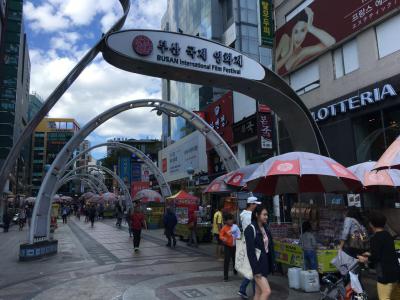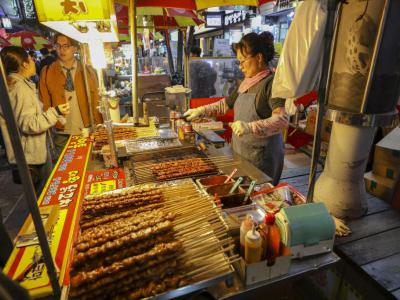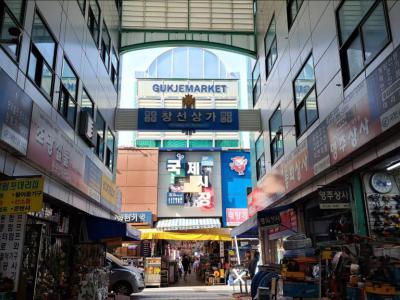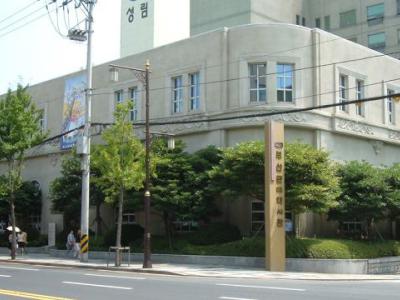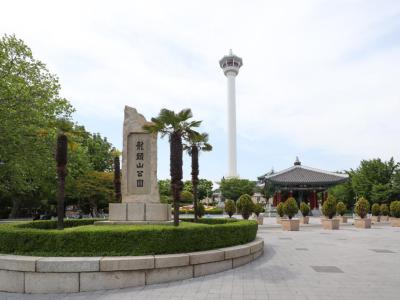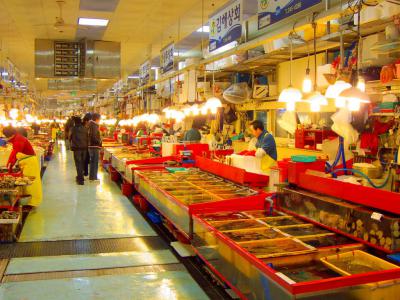Busan Introduction Walking Tour (Self Guided), Busan
Nestled along the southeastern coast of South Korea, the vibrant metropolis of Busan is teeming with tradition, culture, and modernity. During the summer months, the city becomes a magnet for tourists seeking its pristine beaches, where they can bask in the sun and enjoy aquatic activities. However, Busan offers more than just coastal delights. As a coastal hub, it presents an array of attractions year-round, catering to visitors of all preferences and interests.
The name "Busan" (previously spelled "Pusan") originates from the Sino-Korean term for "Cauldron Mountain," associated with Mount Hwangryeong, west of the city center.
From the 15th century, Busan was designated by the Korean government as a trading port with Japan, allowing Japanese settlement. Despite declines in other Japanese settlements on the Korean peninsula, Busan persisted until Japan's invasion in 1592. In 1876, it became Korea's first international port, and during Japanese rule, Busan flourished as a commercial hub.
During the Korean War, Busan was one of only two cities in South Korea not seized by the North Korean army initially, leading to its becoming a refugee camp. Remaining under South Korean control throughout the conflict, Busan temporarily acted as the country's de facto capital, with UN troops establishing the defensive Pusan Perimeter. Since then, Busan has developed into a resilient and self-governing municipal center, showcasing a strong urban character.
One of the city's iconic landmarks is BIFF Square, renowned for its association with the Busan International Film Festival, showcasing the city's significance in the global cinematic landscape. Nearby, Changseon-dong Food Alley offers a tantalizing array of culinary delights, inviting visitors to indulge in authentic Korean flavors.
Nature enthusiasts will find solace in Yongdusan Park, home to the iconic Busan Tower, offering panoramic views of the cityscape and the azure coastline beyond. Meanwhile, fashion aficionados can explore the trendy boutiques lining Gwangbokro Fashion Street, showcasing the latest trends in Korean fashion.
To complete your visit to Busan, take a stroll through Jagalchi Market, the largest seafood market in the country.
As you explore the myriad facets of Busan, you'll uncover an energetic blend of sights and sounds. So, put on your walking shoes and treat yourself to an unforgettable journey through the heart of this dynamic city!
The name "Busan" (previously spelled "Pusan") originates from the Sino-Korean term for "Cauldron Mountain," associated with Mount Hwangryeong, west of the city center.
From the 15th century, Busan was designated by the Korean government as a trading port with Japan, allowing Japanese settlement. Despite declines in other Japanese settlements on the Korean peninsula, Busan persisted until Japan's invasion in 1592. In 1876, it became Korea's first international port, and during Japanese rule, Busan flourished as a commercial hub.
During the Korean War, Busan was one of only two cities in South Korea not seized by the North Korean army initially, leading to its becoming a refugee camp. Remaining under South Korean control throughout the conflict, Busan temporarily acted as the country's de facto capital, with UN troops establishing the defensive Pusan Perimeter. Since then, Busan has developed into a resilient and self-governing municipal center, showcasing a strong urban character.
One of the city's iconic landmarks is BIFF Square, renowned for its association with the Busan International Film Festival, showcasing the city's significance in the global cinematic landscape. Nearby, Changseon-dong Food Alley offers a tantalizing array of culinary delights, inviting visitors to indulge in authentic Korean flavors.
Nature enthusiasts will find solace in Yongdusan Park, home to the iconic Busan Tower, offering panoramic views of the cityscape and the azure coastline beyond. Meanwhile, fashion aficionados can explore the trendy boutiques lining Gwangbokro Fashion Street, showcasing the latest trends in Korean fashion.
To complete your visit to Busan, take a stroll through Jagalchi Market, the largest seafood market in the country.
As you explore the myriad facets of Busan, you'll uncover an energetic blend of sights and sounds. So, put on your walking shoes and treat yourself to an unforgettable journey through the heart of this dynamic city!
How it works: Download the app "GPSmyCity: Walks in 1K+ Cities" from Apple App Store or Google Play Store to your mobile phone or tablet. The app turns your mobile device into a personal tour guide and its built-in GPS navigation functions guide you from one tour stop to next. The app works offline, so no data plan is needed when traveling abroad.
Busan Introduction Walking Tour Map
Guide Name: Busan Introduction Walking Tour
Guide Location: South Korea » Busan (See other walking tours in Busan)
Guide Type: Self-guided Walking Tour (Sightseeing)
# of Attractions: 8
Tour Duration: 1 Hour(s)
Travel Distance: 2.4 Km or 1.5 Miles
Author: DanaOffice
Sight(s) Featured in This Guide:
Guide Location: South Korea » Busan (See other walking tours in Busan)
Guide Type: Self-guided Walking Tour (Sightseeing)
# of Attractions: 8
Tour Duration: 1 Hour(s)
Travel Distance: 2.4 Km or 1.5 Miles
Author: DanaOffice
Sight(s) Featured in This Guide:
- BIFF Square
- Changseondong Meokja Golmok (Changseon-dong Food Alley)
- Gukje Market
- Busan Modern History Museum
- Yongdusan Park
- Busan Tower
- Gwangbokro Fashion street
- Jagalchi Market
1) BIFF Square (must see)
BIFF Square is a dynamic and vibrant area that pays homage to the city's film industry, particularly the Busan International Film Festival (BIFF). This bustling square offers visitors a multifaceted experience, combining cinematic culture, delectable street food, and unique souvenir shops.
The square is strategically situated near prominent markets such as Gukje Market, Kkangtong Market, and Jagalchi Market, enhancing its appeal as a central hub of activity. One notable attraction within BIFF Square is the commemoration of renowned individuals in the film industry. Handprints of esteemed figures like Ennio Morricone, Jeremy Irons, Juliette Binoche, Willem Dafoe, and Lee Jangho are imprinted on the square, creating a tangible connection to the world of cinema.
For travelers seeking an authentic taste of Busan's culinary scene, BIFF Square is a culinary haven. Various street food stalls line the vibrant alleyways, offering a diverse array of local delicacies deeply rooted in South Korea's culinary heritage. The aromatic scents emanating from these stalls tempt passersby to indulge in the rich and flavorful offerings.
Tteokbokki, a popular spicy rice cake dish, is a recommended starting point for those eager to explore Korean flavors. Known for its harmonious blend of sweet, spicy, and umami tastes, Tteokbokki showcases the skillful balance that characterizes Korean cuisine.
Whether you're a film enthusiast, a food lover, or a souvenir hunter, BIFF Square promises a memorable experience in the lively city of Busan.
The square is strategically situated near prominent markets such as Gukje Market, Kkangtong Market, and Jagalchi Market, enhancing its appeal as a central hub of activity. One notable attraction within BIFF Square is the commemoration of renowned individuals in the film industry. Handprints of esteemed figures like Ennio Morricone, Jeremy Irons, Juliette Binoche, Willem Dafoe, and Lee Jangho are imprinted on the square, creating a tangible connection to the world of cinema.
For travelers seeking an authentic taste of Busan's culinary scene, BIFF Square is a culinary haven. Various street food stalls line the vibrant alleyways, offering a diverse array of local delicacies deeply rooted in South Korea's culinary heritage. The aromatic scents emanating from these stalls tempt passersby to indulge in the rich and flavorful offerings.
Tteokbokki, a popular spicy rice cake dish, is a recommended starting point for those eager to explore Korean flavors. Known for its harmonious blend of sweet, spicy, and umami tastes, Tteokbokki showcases the skillful balance that characterizes Korean cuisine.
Whether you're a film enthusiast, a food lover, or a souvenir hunter, BIFF Square promises a memorable experience in the lively city of Busan.
2) Changseondong Meokja Golmok (Changseon-dong Food Alley)
Changseon-dong Food Alley, affectionately dubbed Busan's "Let's Eat" Alley, stands as a vibrant testament to the city's culinary diversity and the warmth of its street food culture. The alley's charm lies not only in its mouthwatering offerings but also in the simplicity and efficiency of the dining experience. As you stroll through the inviting red archway into the alley, you are greeted by a colorful array of stalls vying for your attention. Here, there's no need for the customary wait for a server to seat you or the disappointment of a dish that fails to match its menu portrayal. In Changseondong, what you see is undeniably what you get.
The heart and soul of each stall are the elderly Korean women, affectionately referred to as "ajummas," who skillfully prepare and serve the tantalizing array of dishes. These experienced cooks bring a personal touch to every meal, ensuring that visitors not only savor the flavors but also feel the warmth of Busan's hospitality.
Among the culinary delights awaiting eager patrons are the fiery and flavorful bibimdangmyeon, featuring spicy glass noodles, and the savory napjakmandu, delectable flat dumplings. For those with more diverse tastes, the alley caters to gourmands with a tempting variety of traditional Korean dishes, including the iconic tteokbokki (stir-fried rice cake), pajeon (green onion pancake), kimbap, and japchae (sweet potato noodles).
One of the most alluring aspects of Changseondong Meokja Golmok is the affordability of its offerings. With prices ranging from ₩2,000 to ₩5,000 (approximately $2 to $5 CAD), visitors can indulge in an array of culinary delights without breaking the bank. This accessibility further enhances the alley's appeal, inviting locals and tourists alike to explore and savor the diverse flavors of Busan's street food scene.
The heart and soul of each stall are the elderly Korean women, affectionately referred to as "ajummas," who skillfully prepare and serve the tantalizing array of dishes. These experienced cooks bring a personal touch to every meal, ensuring that visitors not only savor the flavors but also feel the warmth of Busan's hospitality.
Among the culinary delights awaiting eager patrons are the fiery and flavorful bibimdangmyeon, featuring spicy glass noodles, and the savory napjakmandu, delectable flat dumplings. For those with more diverse tastes, the alley caters to gourmands with a tempting variety of traditional Korean dishes, including the iconic tteokbokki (stir-fried rice cake), pajeon (green onion pancake), kimbap, and japchae (sweet potato noodles).
One of the most alluring aspects of Changseondong Meokja Golmok is the affordability of its offerings. With prices ranging from ₩2,000 to ₩5,000 (approximately $2 to $5 CAD), visitors can indulge in an array of culinary delights without breaking the bank. This accessibility further enhances the alley's appeal, inviting locals and tourists alike to explore and savor the diverse flavors of Busan's street food scene.
3) Gukje Market
Gukje Market is a bustling and lively marketplace with a rich history and a vibrant atmosphere. Emerging after the Korean War, the market gained prominence as a hub for US army items and various goods gathered in the refugee capital of Busan. Alongside Bupyeong Kkangtong Market, Jagalchi Market, and Bosu Book Street, Gukje Market forms the "Original Mega Commercial District of Busan."
The market experienced a resurgence in popularity with the success of the movie "Ode to My Father," which focuses on the vibrant and dynamic environment of Gukje Market. A distinctive landmark within the market is the suspension bridge that connects the market building to others. Exploring Gukje Market is akin to navigating a maze, with buildings creating alleys and smaller lanes that contribute to the lively and maze-like atmosphere. The arcade covering the sky, stores facing each other on the alley, and the suspension bridge create an indoor amusement park feel, making it an exciting and immersive experience for visitors.
Notable locations within Gukje Market include Kkotbunine, featured in the film "Ode to My Father," and distinctive alleys such as the hanbok alley and the bedding alley. The market offers a diverse array of items for sale, ranging from toys and princess bags to unique finds like ugly dolls. Visitors are encouraged to take their time exploring, as hidden treasures can be discovered among the piles of goods.
A crucial aspect of the Gukje Market experience is indulging in delectable street food. Street vendors offer a variety of authentic Korean dishes, including Chungmu Gimbap, Bbibim dangmyeon (spicy glass noodles), eomuk (fish cake), tteokbokki (spicy rice cakes), fritters, and blood sausages. Eating while standing becomes a unique and memorable experience, adding to the authentic charm of the market.
The market experienced a resurgence in popularity with the success of the movie "Ode to My Father," which focuses on the vibrant and dynamic environment of Gukje Market. A distinctive landmark within the market is the suspension bridge that connects the market building to others. Exploring Gukje Market is akin to navigating a maze, with buildings creating alleys and smaller lanes that contribute to the lively and maze-like atmosphere. The arcade covering the sky, stores facing each other on the alley, and the suspension bridge create an indoor amusement park feel, making it an exciting and immersive experience for visitors.
Notable locations within Gukje Market include Kkotbunine, featured in the film "Ode to My Father," and distinctive alleys such as the hanbok alley and the bedding alley. The market offers a diverse array of items for sale, ranging from toys and princess bags to unique finds like ugly dolls. Visitors are encouraged to take their time exploring, as hidden treasures can be discovered among the piles of goods.
A crucial aspect of the Gukje Market experience is indulging in delectable street food. Street vendors offer a variety of authentic Korean dishes, including Chungmu Gimbap, Bbibim dangmyeon (spicy glass noodles), eomuk (fish cake), tteokbokki (spicy rice cakes), fritters, and blood sausages. Eating while standing becomes a unique and memorable experience, adding to the authentic charm of the market.
4) Busan Modern History Museum
The Busan Modern History Museum stands as a poignant reminder of the tumultuous history that Busan endured during the Japanese occupation. A bridgehead for Japan's invasion of the continent, Busan retains traces of the suffering inflicted during this period, and the museum aims to tell the city's compelling story, urging visitors not to forget the brutal experiences.
The building, constructed with reinforcement and concrete in the 1920s, reflects the architectural trends of that era when Western styles were introduced. Designated as Busan Monument No. 49 in 2001, the museum has become a recognized symbol of historical value and architectural significance. Following the liberation, the building served as the U.S. Cultural Center in Busan for 50 years without permission, eventually being returned to the Korean government due to persistent demands from Busan citizens.
Since its opening on July 3, 2003, the Busan Modern History Museum has served as a crucial space for understanding and remembering the city's modern and contemporary history through relics and exhibits related to Busan.The museum comprises the 1st and 2nd Exhibition Halls and the Modern Street in Busan. The 1st Exhibition Hall chronicles Busan's historical timeline, from the opening of its port to modernization during the Japanese occupation. The 2nd Exhibition Hall focuses on the Oriental Development Company and the history of Korea–US relations during a challenging period. The Oriental Development Company played a pivotal role in exploiting the land and collecting rent, leading to the suffering of tenant farmers under Japanese colonial rule.
The Modern Street in Busan is a noteworthy reproduction of the Daecheong-dong street during the Japanese occupation, featuring shops that provide insight into the commercial center of Busan at that time. Additionally, a model of a trolley that used to run in downtown Busan enhances the immersive experience, transporting visitors back in time.
The building, constructed with reinforcement and concrete in the 1920s, reflects the architectural trends of that era when Western styles were introduced. Designated as Busan Monument No. 49 in 2001, the museum has become a recognized symbol of historical value and architectural significance. Following the liberation, the building served as the U.S. Cultural Center in Busan for 50 years without permission, eventually being returned to the Korean government due to persistent demands from Busan citizens.
Since its opening on July 3, 2003, the Busan Modern History Museum has served as a crucial space for understanding and remembering the city's modern and contemporary history through relics and exhibits related to Busan.The museum comprises the 1st and 2nd Exhibition Halls and the Modern Street in Busan. The 1st Exhibition Hall chronicles Busan's historical timeline, from the opening of its port to modernization during the Japanese occupation. The 2nd Exhibition Hall focuses on the Oriental Development Company and the history of Korea–US relations during a challenging period. The Oriental Development Company played a pivotal role in exploiting the land and collecting rent, leading to the suffering of tenant farmers under Japanese colonial rule.
The Modern Street in Busan is a noteworthy reproduction of the Daecheong-dong street during the Japanese occupation, featuring shops that provide insight into the commercial center of Busan at that time. Additionally, a model of a trolley that used to run in downtown Busan enhances the immersive experience, transporting visitors back in time.
5) Yongdusan Park
Perched atop the mountain, Yongdusan Park boasts a range of attractions and features, making it a delightful destination. Among the notable elements to explore within the park are the statue of Admiral Yi Sun-sin, renowned for inventing the Turtle Ship, a pivotal invention in naval history. Additionally, visitors can encounter the Bell of the Citizens, a symbolic structure resonating with historical significance. Other notable features include a Flower Clock, adding a touch of natural beauty and timekeeping charm to the park, and a bust of Baeksan An Hee-je, an independence activist.
Yongdusan Park holds historical significance from the Korean War era, serving as a refuge for many people who sought safety amid the turmoil. During the war, when populated areas became targets, individuals found solace on this mountain, as it remained relatively unaffected. Houses were built closely together to foster a sense of security. However, tragedy struck when a significant fire destroyed these dwellings. In the aftermath, the park was established, and settlers were relocated, marking a new chapter in the area's history.
Enveloped in lush greenery, Yongdusan Park is home to over 70 different tree species. This diverse flora offers enchanting vistas, with vibrant leaves during the autumn season and blossoming flowers in spring. The park's natural beauty complements its cultural and historical elements, creating a harmonious environment for visitors to enjoy.
As an integral part of Busan's landscape, Yongdusan Park continues to be a cherished space for both locals and visitors seeking respite and cultural enrichment.
Yongdusan Park holds historical significance from the Korean War era, serving as a refuge for many people who sought safety amid the turmoil. During the war, when populated areas became targets, individuals found solace on this mountain, as it remained relatively unaffected. Houses were built closely together to foster a sense of security. However, tragedy struck when a significant fire destroyed these dwellings. In the aftermath, the park was established, and settlers were relocated, marking a new chapter in the area's history.
Enveloped in lush greenery, Yongdusan Park is home to over 70 different tree species. This diverse flora offers enchanting vistas, with vibrant leaves during the autumn season and blossoming flowers in spring. The park's natural beauty complements its cultural and historical elements, creating a harmonious environment for visitors to enjoy.
As an integral part of Busan's landscape, Yongdusan Park continues to be a cherished space for both locals and visitors seeking respite and cultural enrichment.
6) Busan Tower
Perched atop Yongdusan Park, Busan Tower stands at an impressive height of 120 meters, grassing the skyline of Busan. This prominent observation tower not only offers breathtaking panoramic views of the bustling Busan Port and the scenic Yeongdo Island but also provides visitors with a captivating array of entertainment and attractions.
One of the standout features of Busan Tower is the nightly fireworks mapping show, a captivating spectacle that transforms the tower into a canvas for graphical displays. As darkness descends, vivid images are projected onto the tower's windows, creating a mesmerizing backdrop against the twinkling lights of the Busan Port Bridge. This multimedia show adds an enchanting and dynamic element to the already stunning night view, making it a must-see experience for both locals and tourists alike.
Descending to the lower floors of Busan Tower reveals a world of amusement and thematic exploration. The lower level is ingeniously themed around a flying submarine, offering a unique and entertaining experience for visitors of all ages. Moving up to the second floor, visitors encounter a photo zone and themed rooms that transport them to famous travel destinations within Busan. Each room is thoughtfully adorned with elements that capture the essence of Busan's cultural and natural landmarks, allowing guests to embark on a visual journey through the city's diverse attractions.
In essence, Busan Tower is a place where visitors can marvel at the cityscape, immerse themselves in creative displays, and explore themed spaces that celebrate the unique charm of Busan.
One of the standout features of Busan Tower is the nightly fireworks mapping show, a captivating spectacle that transforms the tower into a canvas for graphical displays. As darkness descends, vivid images are projected onto the tower's windows, creating a mesmerizing backdrop against the twinkling lights of the Busan Port Bridge. This multimedia show adds an enchanting and dynamic element to the already stunning night view, making it a must-see experience for both locals and tourists alike.
Descending to the lower floors of Busan Tower reveals a world of amusement and thematic exploration. The lower level is ingeniously themed around a flying submarine, offering a unique and entertaining experience for visitors of all ages. Moving up to the second floor, visitors encounter a photo zone and themed rooms that transport them to famous travel destinations within Busan. Each room is thoughtfully adorned with elements that capture the essence of Busan's cultural and natural landmarks, allowing guests to embark on a visual journey through the city's diverse attractions.
In essence, Busan Tower is a place where visitors can marvel at the cityscape, immerse themselves in creative displays, and explore themed spaces that celebrate the unique charm of Busan.
7) Gwangbokro Fashion street
Gwangbok-ro Fashion Street stands as a vibrant and dynamic shopping destination, attracting both locals and foreign tourists alike. Known for its diverse array of clothing stores, unique fashion concepts, and a wide range of products, this bustling street caters to individuals of all ages, making it a popular hub for fashion enthusiasts.
Foreign tourists, in particular, are drawn to the street's various clothing stores, showcasing Korea's native brands and offering distinctive fashion concepts. Beyond catering to the younger demographic, Gwangbok-ro Fashion Street caters to individuals of all ages, ensuring that everyone can find satisfaction among the diverse fashion items available. The variety of stores spans hanbok (traditional Korean clothing) shops, opticians, sports and outdoor apparel stores, high-fashion brand outlets, and more, creating a comprehensive shopping experience.
Gwangbok-ro Fashion Street is not only a place to explore the latest fashion trends but also a showcase of the city's history and spirit. The street is adorned with beautiful decorations, including splendid lighting, abundant flowerbeds, exquisite sculptures, and welcoming resting spots.
The name "Gwangbok-ro" itself is symbolic, combining "gwangbok" meaning liberation and "fashion." The street's proximity to Busan's sea holds historical significance, representing the site where Japanese imperialists exploited Koreans and where locals fought against Japan for their country's independence. Following liberation, Busan citizens named the area "Gwangbok-dong" to celebrate Korea's independence and commemorate the local people's anti-Japanese movement.
Foreign tourists, in particular, are drawn to the street's various clothing stores, showcasing Korea's native brands and offering distinctive fashion concepts. Beyond catering to the younger demographic, Gwangbok-ro Fashion Street caters to individuals of all ages, ensuring that everyone can find satisfaction among the diverse fashion items available. The variety of stores spans hanbok (traditional Korean clothing) shops, opticians, sports and outdoor apparel stores, high-fashion brand outlets, and more, creating a comprehensive shopping experience.
Gwangbok-ro Fashion Street is not only a place to explore the latest fashion trends but also a showcase of the city's history and spirit. The street is adorned with beautiful decorations, including splendid lighting, abundant flowerbeds, exquisite sculptures, and welcoming resting spots.
The name "Gwangbok-ro" itself is symbolic, combining "gwangbok" meaning liberation and "fashion." The street's proximity to Busan's sea holds historical significance, representing the site where Japanese imperialists exploited Koreans and where locals fought against Japan for their country's independence. Following liberation, Busan citizens named the area "Gwangbok-dong" to celebrate Korea's independence and commemorate the local people's anti-Japanese movement.
8) Jagalchi Market (must see)
Jagalchi Market, located on the edge of Nampo Port in Busan, stands as a vibrant and bustling seafood haven, earning its reputation as the largest fish market in the country. This iconic market has become one of the ten landmarks of Busan, drawing numerous tourists who seek an authentic and lively shopping experience.
The name "Jagalchi" is believed to have originated from the Korean word "jagal," meaning gravel, reflecting the market's history when it was surrounded by gravel. Spanning an impressive 3 kilometers, Jagalchi Market offers a diverse array of goods, making it a comprehensive destination for seafood enthusiasts and curious visitors alike.
As visitors explore the market, they encounter a rich variety of seafood products. Near the Yeongdo Grand Bridge, stalls showcase dehydrated anchovies, sea laver, and an assortment of shellfish, providing a glimpse into the abundance of marine delicacies available. Additionally, shops across from the city hall specialize in herbal medicine and animal-based remedies, adding an extra layer of diversity to the market's offerings.
A distinctive feature of Jagalchi Market is the prominent role played by its female vendors, affectionately known as "Jagalchi Ajumma." This term harks back to the post-Korean War era when women took to the streets to sell goods in this area, contributing to the market's unique atmosphere and character.
One of the highlights of Jagalchi Market is the annual Busan Jagalchi Festival held in the autumn. With the lively slogan "Oiso! Boiso! Saiso!" ("Come! See! Buy!"), the festival invites participants to engage in a variety of activities, including singing, dancing, fish-catching, and indulging in the freshest seafood offerings.
The name "Jagalchi" is believed to have originated from the Korean word "jagal," meaning gravel, reflecting the market's history when it was surrounded by gravel. Spanning an impressive 3 kilometers, Jagalchi Market offers a diverse array of goods, making it a comprehensive destination for seafood enthusiasts and curious visitors alike.
As visitors explore the market, they encounter a rich variety of seafood products. Near the Yeongdo Grand Bridge, stalls showcase dehydrated anchovies, sea laver, and an assortment of shellfish, providing a glimpse into the abundance of marine delicacies available. Additionally, shops across from the city hall specialize in herbal medicine and animal-based remedies, adding an extra layer of diversity to the market's offerings.
A distinctive feature of Jagalchi Market is the prominent role played by its female vendors, affectionately known as "Jagalchi Ajumma." This term harks back to the post-Korean War era when women took to the streets to sell goods in this area, contributing to the market's unique atmosphere and character.
One of the highlights of Jagalchi Market is the annual Busan Jagalchi Festival held in the autumn. With the lively slogan "Oiso! Boiso! Saiso!" ("Come! See! Buy!"), the festival invites participants to engage in a variety of activities, including singing, dancing, fish-catching, and indulging in the freshest seafood offerings.
The Most Popular Cities
/ view all



